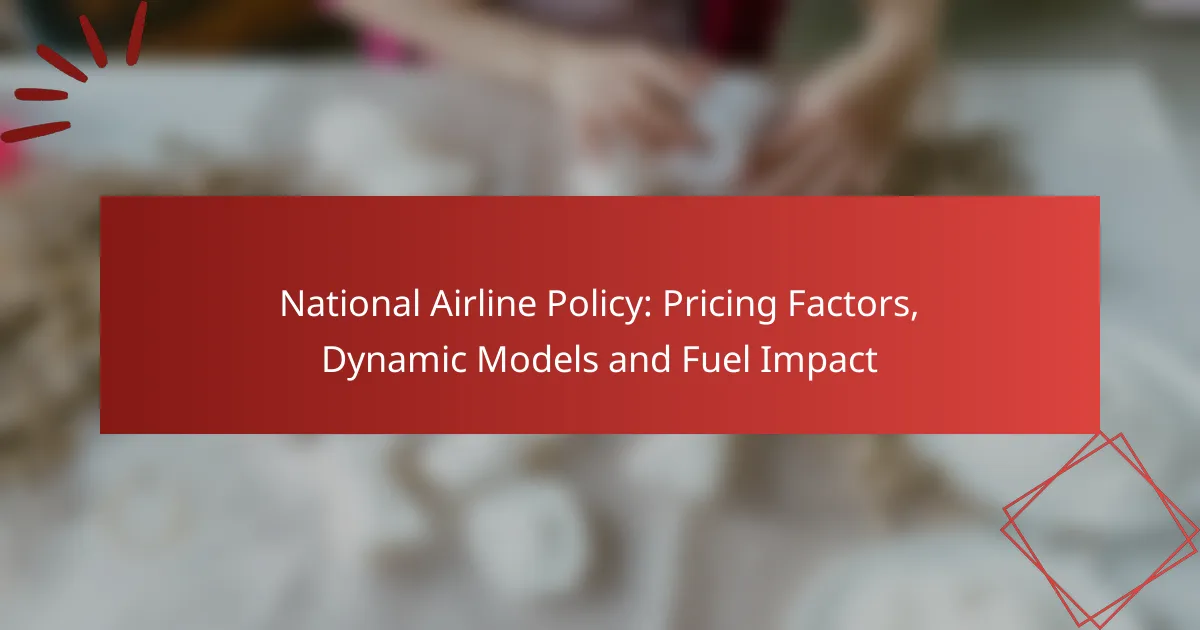The national airline policy encompasses various pricing factors that are crucial for airlines to remain competitive and profitable. Key elements such as operating costs, market demand, and fuel prices play a significant role in shaping ticket prices. Additionally, dynamic pricing models allow airlines to adjust fares in real-time, responding to changes in demand and competition. Understanding these dynamics is essential for navigating the complexities of the aviation market.
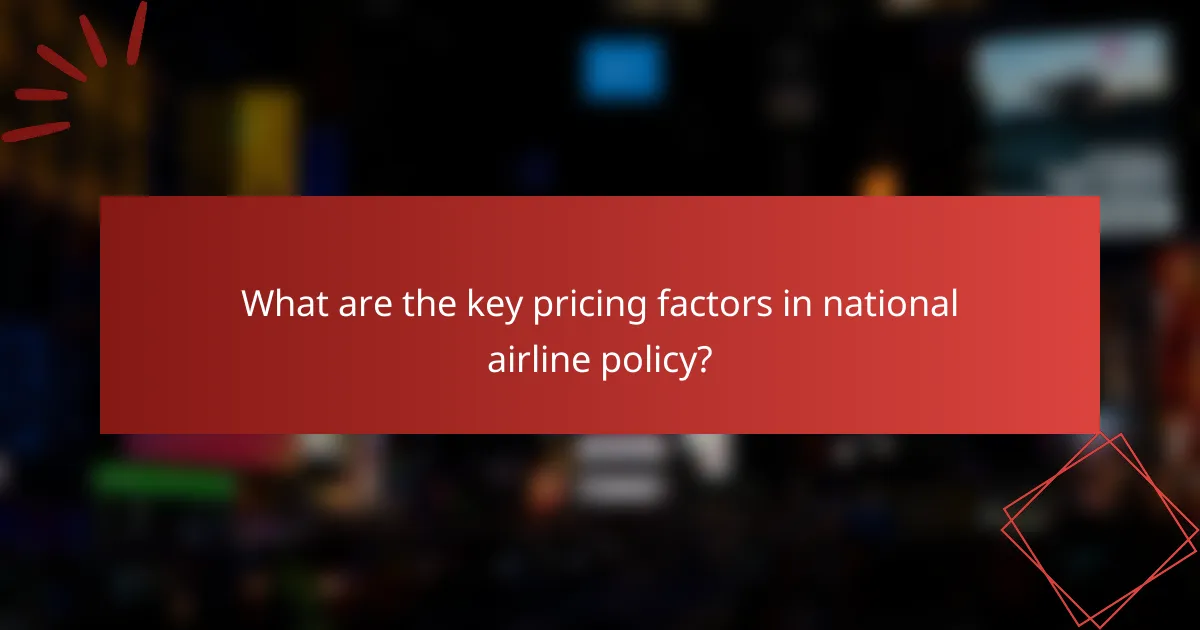
What are the key pricing factors in national airline policy?
The key pricing factors in national airline policy include operating costs, market demand, regulatory fees, competition analysis, and seasonal variations. Understanding these elements helps airlines set competitive and profitable ticket prices while navigating the complexities of the aviation market.
Operating costs
Operating costs are the expenses incurred by airlines to run their services, including fuel, maintenance, crew salaries, and airport fees. Fuel costs, in particular, can fluctuate significantly, impacting overall pricing strategies. Airlines must continuously monitor these costs to adjust fares accordingly and maintain profitability.
For instance, if fuel prices rise sharply, airlines may increase ticket prices to offset the additional expenses. Conversely, lower fuel prices can lead to reduced fares, benefiting consumers.
Market demand
Market demand refers to the number of passengers willing to purchase tickets at various price points. Airlines analyze historical data and current trends to forecast demand, which influences pricing decisions. High demand periods, such as holidays or major events, often lead to higher fares.
Airlines can use dynamic pricing models to adjust fares in real-time based on demand fluctuations. For example, if a flight is filling up quickly, prices may increase to maximize revenue from remaining seats.
Regulatory fees
Regulatory fees are charges imposed by government authorities on airlines, which can include taxes, landing fees, and safety compliance costs. These fees vary by country and can significantly affect ticket pricing. Airlines must factor these costs into their pricing models to ensure compliance and financial viability.
For example, in the European Union, airlines face various environmental taxes that can influence fare structures. Understanding local regulations is crucial for airlines operating in multiple jurisdictions.
Competition analysis
Competition analysis involves evaluating the pricing strategies of rival airlines to remain competitive in the market. Airlines must consider both direct competitors and alternative transportation options, such as trains or buses, when setting prices. A thorough analysis helps airlines identify pricing trends and adjust their fares to attract customers.
For instance, if a competitor lowers its prices on a popular route, an airline may need to respond with similar fare reductions to maintain market share.
Seasonal variations
Seasonal variations affect travel patterns and pricing, as demand can significantly change throughout the year. Airlines often experience peak seasons during holidays and summer vacations, leading to higher prices. Conversely, off-peak seasons may see lower fares to stimulate demand.
Airlines can implement pricing strategies that capitalize on these seasonal trends, such as offering discounts during slower periods to fill seats. Understanding the seasonal dynamics of specific routes can enhance revenue management efforts.
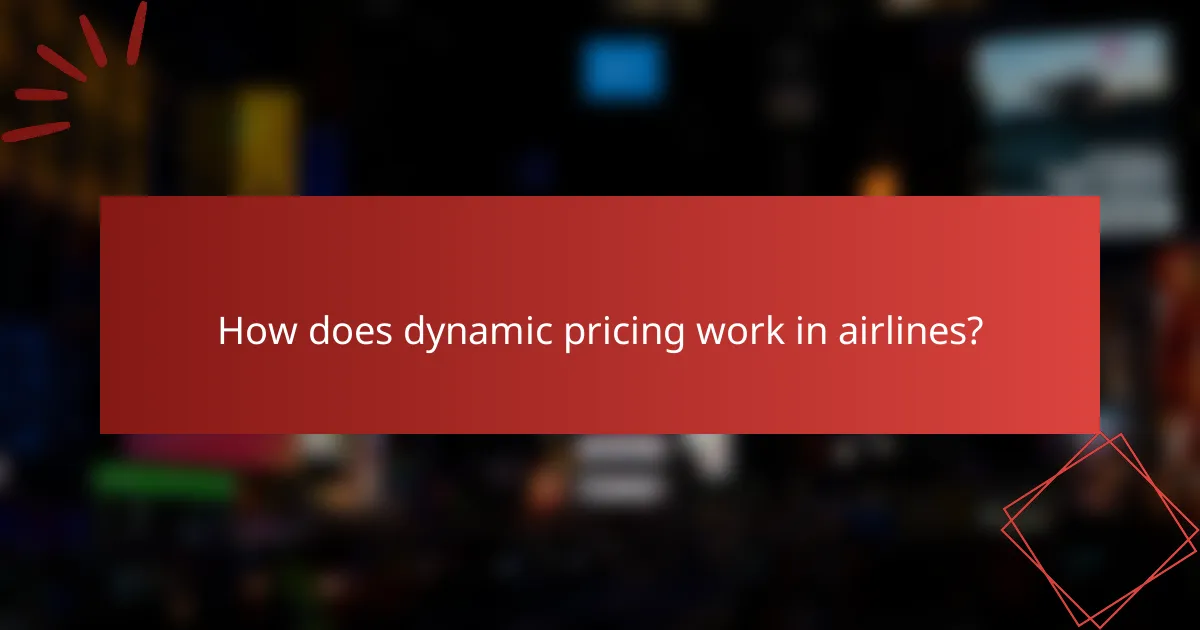
How does dynamic pricing work in airlines?
Dynamic pricing in airlines adjusts ticket prices based on various factors such as demand, competition, and time until departure. This strategy enables airlines to maximize revenue by altering fares in real-time to reflect market conditions.
Real-time data analysis
Airlines utilize real-time data analysis to monitor fluctuations in demand, competitor pricing, and market trends. This information is gathered from various sources, including booking patterns and social media sentiment, allowing airlines to make informed pricing decisions quickly.
For example, if a particular route sees a sudden spike in searches, airlines may increase prices to capitalize on that demand. Conversely, if bookings are slow, they might lower fares to attract more customers.
Customer behavior tracking
Tracking customer behavior is crucial for effective dynamic pricing. Airlines analyze past purchasing patterns, search histories, and customer demographics to predict future buying behavior. This data helps airlines tailor their pricing strategies to specific customer segments.
For instance, frequent flyers may receive personalized offers based on their loyalty status, while casual travelers might see different pricing based on their browsing habits. Understanding these behaviors allows airlines to optimize their pricing models.
Algorithmic pricing models
Algorithmic pricing models are at the heart of dynamic pricing in airlines. These models use complex algorithms to set prices based on multiple variables, including time of day, seasonality, and historical data. By automating the pricing process, airlines can respond to market changes more efficiently.
Common models include regression analysis and machine learning techniques, which can predict price elasticity and customer willingness to pay. Airlines must regularly update these algorithms to ensure they reflect current market conditions and consumer behavior accurately.

What is the impact of fuel prices on airline pricing?
Fuel prices significantly influence airline pricing strategies, as they represent a major operational cost. When fuel prices rise, airlines often adjust ticket prices to maintain profitability, which can lead to higher fares for consumers.
Fuel cost fluctuations
Fuel cost fluctuations can vary widely due to geopolitical events, supply chain issues, and seasonal demand. Airlines typically monitor these changes closely, as even a small increase in fuel prices can lead to substantial impacts on overall operating expenses. For example, a rise of just a few dollars per barrel can translate to millions in additional costs for airlines.
Airlines may pass these costs onto consumers through fare increases, especially during peak travel seasons when demand is high. Conversely, when fuel prices drop, airlines might lower fares to attract more passengers, although this is not always guaranteed.
Hedging strategies
Hedging strategies allow airlines to mitigate the impact of volatile fuel prices. By locking in fuel prices through futures contracts or options, airlines can stabilize their operating costs and better predict their financial performance. This practice helps in budgeting and can prevent sudden fare hikes due to unexpected fuel price spikes.
However, hedging comes with risks. If fuel prices fall below the hedged rate, airlines may end up paying more than the market price, which can affect their competitiveness. Effective hedging requires careful analysis and a clear understanding of market trends.
Fuel efficiency measures
Implementing fuel efficiency measures is crucial for airlines to manage fuel costs effectively. This includes investing in newer, more fuel-efficient aircraft and optimizing flight routes to reduce fuel consumption. For instance, airlines may adjust flight paths to avoid adverse weather or use advanced technology to improve aerodynamics.
Additionally, operational practices such as single-engine taxiing and weight reduction through streamlined cargo can contribute to lower fuel usage. Airlines that prioritize fuel efficiency not only save on costs but also enhance their sustainability efforts, appealing to environmentally conscious travelers.
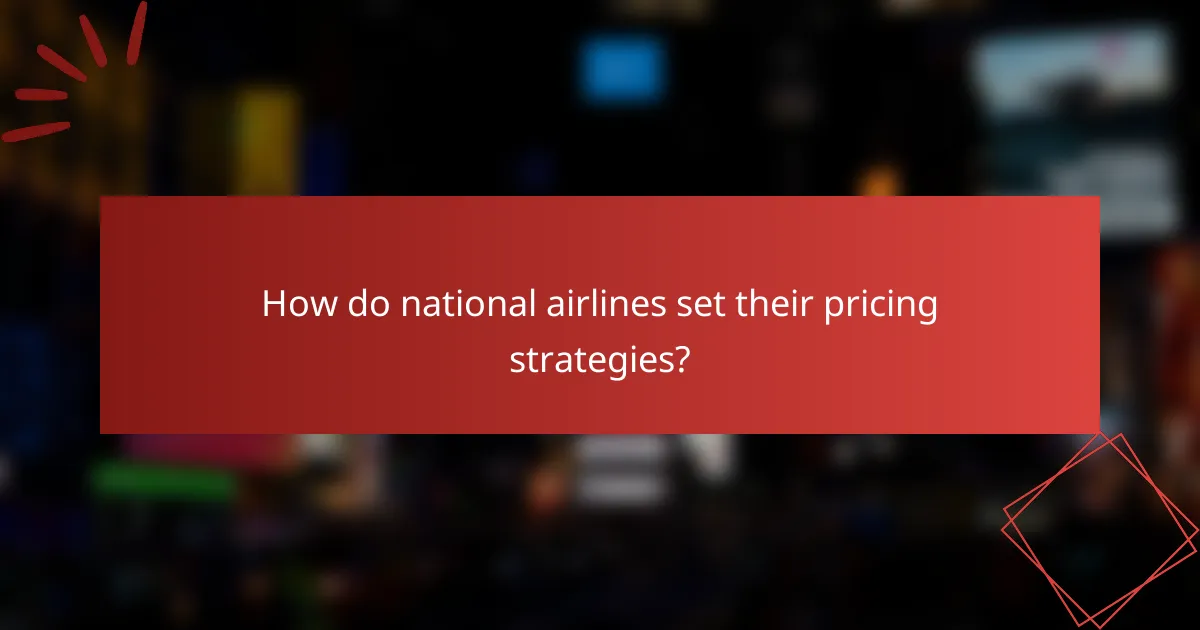
How do national airlines set their pricing strategies?
National airlines set their pricing strategies based on a combination of factors, including operational costs, market demand, and competitive positioning. These strategies often involve various pricing models to maximize revenue while remaining attractive to consumers.
Cost-plus pricing
Cost-plus pricing involves calculating the total operational costs of a flight and adding a markup to ensure profitability. This method is straightforward, as it allows airlines to cover expenses like fuel, maintenance, and labor while generating a consistent profit margin.
For example, if the total cost of operating a flight is estimated at $100,000, an airline might set a ticket price of $120,000 by applying a 20% markup. However, this approach may not always reflect market demand, potentially leading to higher prices than competitors.
Value-based pricing
Value-based pricing focuses on the perceived value of the service to the customer rather than just the costs incurred. Airlines assess what customers are willing to pay based on factors like flight convenience, brand reputation, and additional services offered.
For instance, a national airline might charge more for a direct flight compared to a competitor’s layover option, as customers may value time savings. This strategy requires thorough market research to understand customer preferences and adjust pricing accordingly.
Competitive pricing
Competitive pricing involves setting ticket prices based on what rival airlines charge for similar routes and services. This strategy helps airlines remain competitive in a crowded market, especially for popular destinations.
Airlines often monitor competitors’ prices closely and may adjust their own prices to match or slightly undercut them. However, this approach can lead to price wars, which may erode profit margins if not managed carefully. Airlines should balance competitive pricing with their own cost structures to maintain profitability.
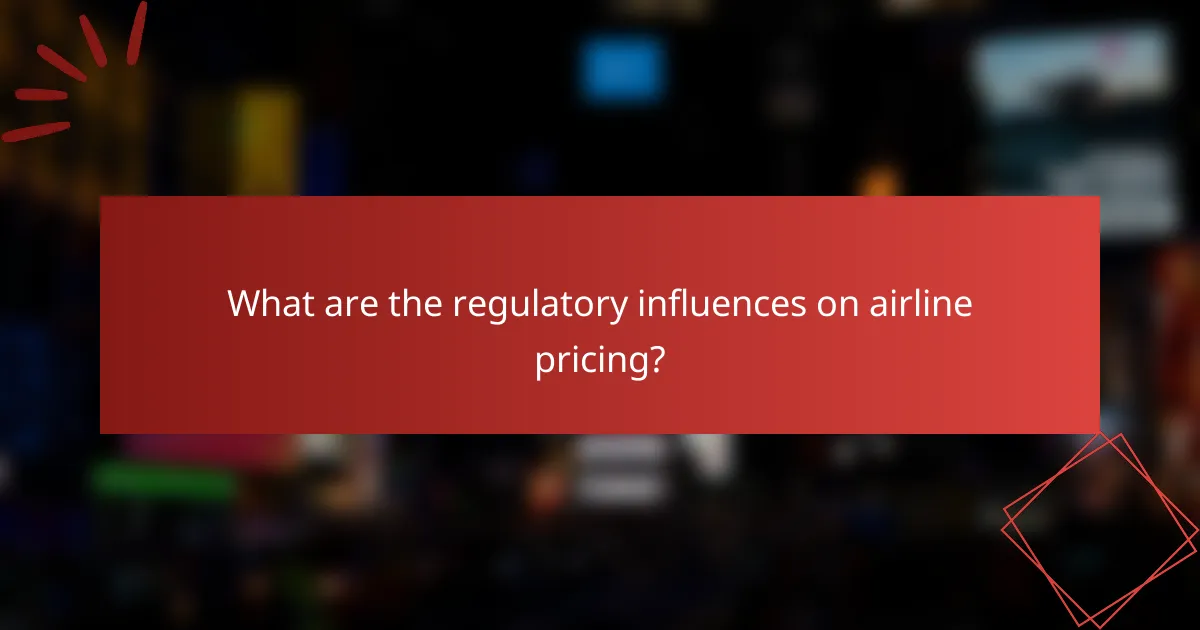
What are the regulatory influences on airline pricing?
Regulatory influences on airline pricing include government regulations, international agreements, and consumer protection laws, all of which shape how airlines set their fares. These factors can significantly impact pricing strategies, operational costs, and ultimately, ticket prices for consumers.
Government regulations
Government regulations play a crucial role in determining airline pricing by establishing frameworks within which airlines must operate. These regulations can include fare caps, minimum pricing requirements, and rules regarding pricing transparency. For instance, in the United States, the Department of Transportation oversees regulations that prevent unfair pricing practices.
Airlines must also comply with safety and operational standards that can affect their cost structures. For example, compliance with safety regulations may require investments in technology and training, which can lead to higher ticket prices.
International agreements
International agreements, such as bilateral air service agreements, influence airline pricing by determining the routes airlines can operate and the fares they can charge. These agreements often involve negotiations between countries to establish fair competition and access to markets. For instance, an open skies agreement can lead to increased competition, potentially lowering fares for consumers.
Airlines operating internationally must navigate various pricing regulations set by different countries, which can complicate fare structures. Understanding these agreements is essential for airlines to optimize their pricing strategies across different markets.
Consumer protection laws
Consumer protection laws are designed to safeguard passengers from unfair pricing practices and ensure transparency in airline pricing. These laws often require airlines to disclose all fees and charges upfront, allowing consumers to make informed decisions. For example, in the European Union, regulations mandate that all-inclusive pricing must be displayed prominently.
Airlines must be cautious to comply with these laws, as violations can lead to fines and damage to their reputation. Ensuring clear communication of pricing and adhering to consumer rights can enhance customer trust and loyalty.
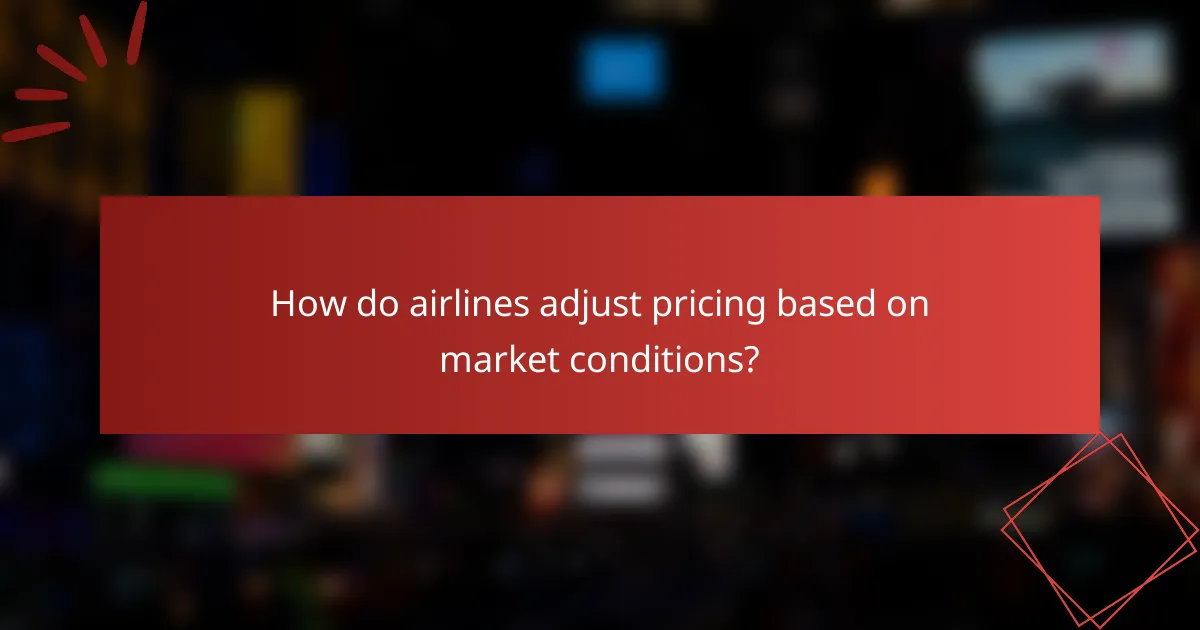
How do airlines adjust pricing based on market conditions?
Airlines adjust pricing based on market conditions through dynamic pricing models that consider demand, competition, and operational costs. By analyzing these factors, airlines can optimize ticket prices to maximize revenue while remaining competitive.
Dynamic Pricing Models
Dynamic pricing models allow airlines to change ticket prices in real-time based on various market factors. These models take into account demand fluctuations, booking patterns, and competitor pricing, enabling airlines to adjust fares accordingly. For instance, prices may rise during peak travel seasons or drop during off-peak times to attract more customers.
Airlines often use algorithms that analyze historical data and current market trends to set prices. This means that a ticket’s price can vary significantly within a short period, depending on how many seats are sold and how close the departure date is.
Factors Influencing Pricing
Several key factors influence airline pricing, including fuel costs, route popularity, and economic conditions. Fuel prices can significantly impact operational costs, leading airlines to adjust fares to maintain profitability. For example, if fuel prices rise sharply, airlines may increase ticket prices to cover these additional expenses.
Additionally, routes with higher demand typically see higher prices. Airlines monitor booking trends and adjust fares based on how many seats are sold and how many remain available. Economic conditions, such as consumer spending and travel trends, also play a crucial role in pricing strategies.
Impact of Fuel Prices
Fuel prices have a direct impact on airline pricing strategies, as they constitute a significant portion of operational costs. When fuel prices increase, airlines often pass these costs onto consumers through higher ticket prices. Conversely, if fuel prices decrease, airlines may lower fares to stimulate demand.
Airlines typically hedge against fuel price fluctuations to manage costs better. This means they may lock in fuel prices for a certain period to avoid sudden spikes. However, the effectiveness of this strategy can vary, and airlines must remain agile in their pricing to respond to market changes.
